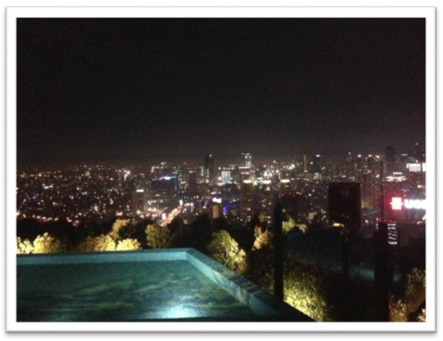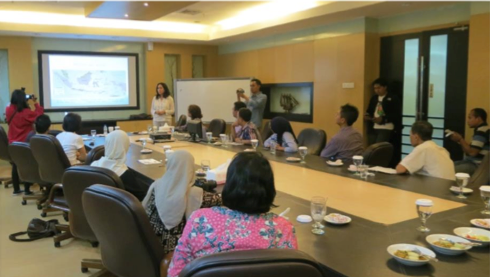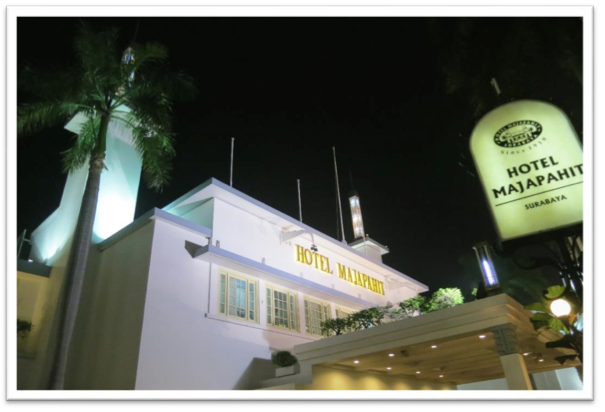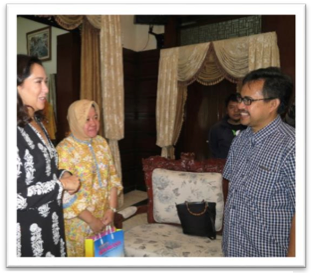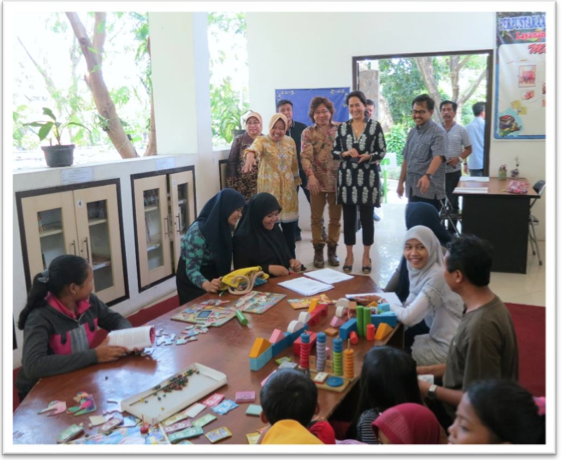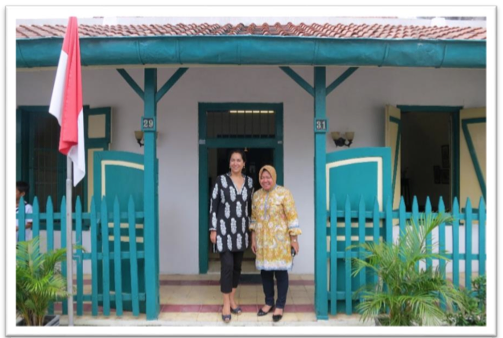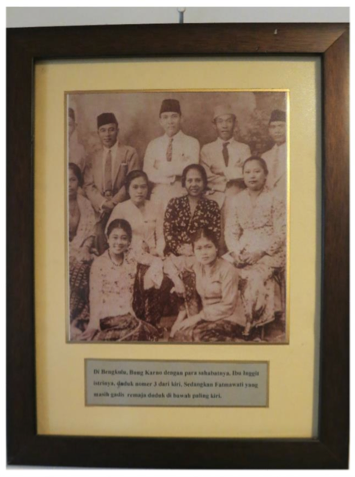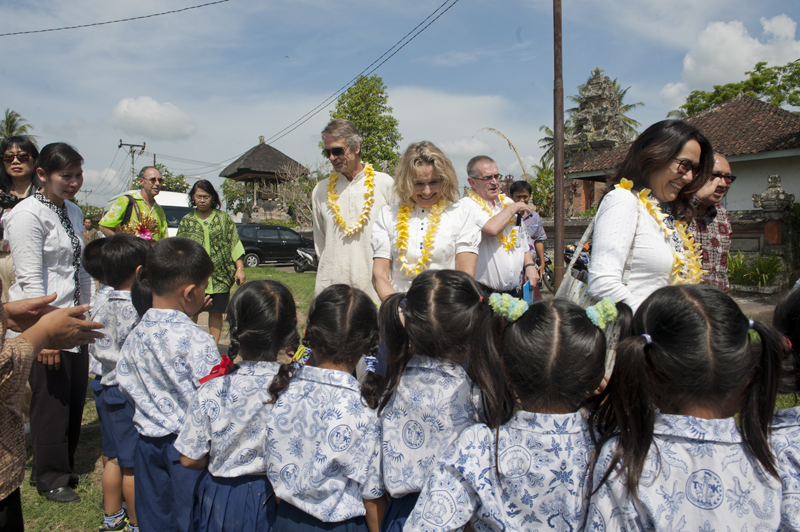
Sample Page
Kartika Soekarno Foundation – December 2019 newsletter
2019 began with a UK trustee visit in Jakarta at the posyandus and Paud centres we have been supporting together with the Australian government. KSF welcomes new team members: Reni Agustina and Clarissa Jazzlyne!
Download the newsletter as a PDF

First KSF Soccer Camp in Collaboration with Mayor of Jakarta-Pusat District
Kartika Soekarno Foundation – December 2018 newsletter
This year, KSF has achieved great results in boosting the quality of basic education in East Java, helped reduce the high rates of infant mortality, young child malnutrition and ill health in the poorest parts of Eastern Indonesia. Our ethos of engaging local governments to fund and replicate our model ensures an organic national development. Peace and Joy for 2019.
Download the newsletter as a PDF

KSF at the House of Lords

Stephen Woodhouse OBE addressing the panel
KSF UK blossomed this spring and new developments are thriving.
KSF is proud to share the news that KSF’s Executive Director, Stephen Woodhouse, was invited to speak at the Annual Commonwealth Day Seminar at the House of Lords about the role of education in emerging economies.
Stephen chose to highlight KSF’s success in local communities with their bi-focal approach of safeguarding early childhood health and optimising schools with KSF teacher training.
Although Indonesia is not part of the Common Wealth, the audience as well as the panel was eager to hear about the KSF approach and to discuss the possibilities of emanating this formula.

Congratulations KSF for making a mark in the space of global NGOs!
Celebrating KSF at Commonwealth Day at the House of Lords:
Founder Kartika Soekarno Seegers, Guest of Honour, Ms Hana Satriyo, who has recently arrived in London with her husband Ambassador Rizal Sukma, and Trustees Brian Sanderson and Joana Schliemann.
Season’s Greetings to all Kartika Soekarno Foundation donors and friends.
2015 brought KSF new government grants from Australia and the Kingdom of Norway. Thanks to their support, we will expand our posyandu revitalization programs (local community centres for early childcare, health and nutrition) in the poorest areas of Jakarta and West Sumba.
Australian Grant
2 years program from 2015 to 2017, Central Jakarta.

Visit to Posyandu Nusa Inda, located in central Jakarta. This village Kebon Melati is the home for 800 families in an area of not more than 16,000 sq metres.
Norwegian Grant
2 year program from 2015 to 2017, West Sumba

Stephen Woodhouse meeting with the local Cadres in Katamawee village, East Nusa Tenggara. These ladies are volunteers working in the maternal health centers. Their knowledge in health and nutrition is still very limited. It will be Sari’s goal to change this, so that many young mothers and babies will benefit. The cadres capacity and community knowledge about nutrition and healthcare are still low.
99% of rural pregnant women are malnourished and anemic, thus resulting in weak body conditions and low birth- weight babies. Many of these babies die of dehydration from diarrhea and diseases.
We will have the full cooperation of the local authorities to tackle this dramatic malnutrition issue and to improve early health and education for young mothers, babies and children. Our pilot projects are selected by the area with the highest level of malnutrition and rates of maternal and infant diseases. The Norwegian Embassy in Indonesia is already working in Sumba to improve the electric outreach for this remote, poor and dry island.

KSF members working with the local government of cials in resolving health, nutrition and early childcare of mother and children issues through the Posyandu Revitalisation program.
New Zealand Grant
Teacher training program in primary schools in Surabaya.
Thanks to the generosity of the Government and people of New Zealand, KSF has been able to initiate a program to improve learning outcomes in more than 200 primary schools serving in excess of 50.000 primary school age +children from low income families in Surabaya. The main focus is to equip school heads with the necessary knowledge and skills to promote better links with and support from local community leaders and parents; to manage schools in a more transparent and learning results oriented manner and to strengthen teachers capacities to promote a child focused learning paradigm. There is strong involvement of local Government such that we expect that KSF pioneering interventions will lead to full replication using funds managed by Government and other donors.
As you can see KSF has been very active over the last few years and we are very grateful to Japan for their continued support in the area of Gianyar.
Next March, I will visit all the projects sponsored by our “blue chip” government donors. We appreciate ongoing support from individual philanthropists and look forward to their even greater support in 2016 and beyond.
Download the newsletter as a PDF
Clinic Booster – by Renjani Puspo Sari
Kartika Soekarno — daughter of former President Sukarno and his Japanese wife Naoko Nemoto, known as Ratna Sari Dewi—was once banned from entering Indonesia. His successor President Suharto also did not allow Sukarno’s children to meet their late father. This political pressure apparently deeply impressed and made the young Kartika want to return to the country even more.
She is now living in Jakarta and actively supporting more than 200 posyandu — an abbreviation for pos pelayanan terpadu, a child and maternal clinic —in Java, Bali and Sumatra to help fight for malnutrition, one of the largest infant problems in Indonesia. According to the government, eight million babies and toddlers are malnourished. Through her Kartika Soekarno Foundation (KSF), she has channeled $117,000 of the Japan government’s funds last year to improve the clinics’ service and revitalize 49 posyandu.
“We have trained about 1,000 volunteers, and also provide basic healthcare such as immunization for expectant mothers, babies and toddlers. The ages zero to five is a crucial time for children to get good nutrition because of the impact on their health and brain development,” says Kartika who founded KSF in New York 16 years ago.
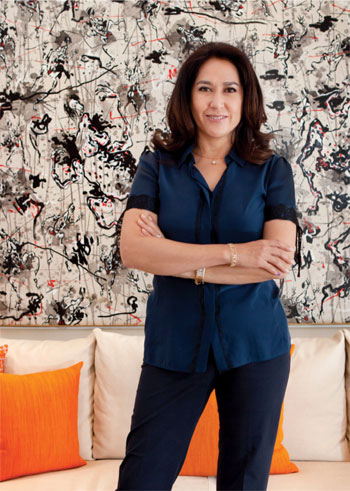
Kartika is a role model for independent women. She sometimes travels alone to the locations to visit her projects, from a small town of Solok in West Sumatra to Gianyar in Bali. She says the volunteers who work for the posyandu always impress her.

Her interest in posyandu started after she visited several clinics in Subang, West Java, in September 1999. Kartika, who at the time lived in New York, was a member of the U.S. National Committee for Unicef. Later she returned to observe clinics in a slum area of Jakarta for the same project. Together with a Dutch top model Annette Lauer, she raised hundred of thousands of dollars for this healthcare project.
As a prominent figure, Kartika can help raise money for charities. For example, she helped Unicef raise $180,000 through a charity event to fund the improvement of education for Indonesian children in remote areas. Currently, she is a member of the American Foundation of Venetian Heritage, which organizes the Venice Art Biennale, and collects funds for the architectural restoration of the city.
Last year, she brought English actor Jeremy Irons to Jakarta and Bali to visit the posyandu while also promoting Irons’ environmental documentary film “Trashed” in 39 cities in Indonesia. The film talks about global waste, and features Jakarta’s Ciliwung River and Bali’s beaches as examples of global pollution. “It’s an important message for Indonesia as there is a difficult situation with the trash here,” she says.
During her childhood, Kartika grew up living in many countries. She was born in Tokyo 47 years ago. Although she is an Indonesian citizen, her mother lived in Paris and Switzerland because of the un- certain political conditions in Indonesia. She doesn’t speak Indonesian fluently; instead she is able to speak English, French and Japanese well. Like her mother, she loves fashion: some of her favorites are Prada, Dries Van Noten and Gucci.
After the death of her father in 1970, she was able to visit Jakarta and sometimes stayed in her stepmother’s house, Hartini Soekarno, or her half sister’s, former President Megawati Soekarnoputri. Kartika has a very close relationship to Megawati, who witnessed her wedding to a Dutch banker Frits Frederik Seegers, now chief executive of Chairul Tanjung’s CT Corp., in Amsterdam in 2005.
“Mbak Mega is a person that I admire. She can act either as a good mother, a politician or as a leader,” says Kartika. Although most of Sukarno’s children are involved in politics, Kartika feels more comfortable as a social activist. Her philanthropy roots go back to a U.S foundation she supported to help the homeless in New York. Before, she was a TV journalist in Tokyo. In 1998, when Indonesia was hit by the financial crisis, she established her own foundation, KSF, with support from Unicef and CARE.
“Jakarta has changed. There are many ultra rich families here, while the middle class is also growing. But, in the other places, there are still people who need help. That’s why our efforts are with children from poor families, to help them have a good education and health,” she says.
In education, KSF has prevented more than 1,900 students from dropping out. It also trained hundreds of teachers in 75 primary schools in Gianyar, Blitar, Kebumen, Trenggalek and Solok. Her foundation also provides scholarships for secondary students to continue their studies at vocational schools. “We also provided grants for schools because the teachers sometimes are not very well paid or not motivated, so we train them to improve the quality of education. When children enjoy going to school, more children can be saved from dropping out,” she says.
Kartika funds her foundation with grants from the Japanese government and other international donors, as well as from private and corporate donations, such as from Freeport, Citibank and BCA.
Indonesia May 2014: The Outset
Leaving London at the cusp of summer behind, I packed up and joined my friend Kartika in Jakarta to go on a fact finding mission and do some idea plotting for her Kartika Soekarno Foundation. I have always loved this archipelago of more than 16.000 tropical islands sprinkled along the equator. I connected with Indonesia a long time ago, in the seventies, when I learned how to swim at the Kartika Plaza Hotel and tried my own version of temple dancing at Borobudur with my sister, who came to us from Manado.
Indonesia is a kaleidoscope of hundreds of different cultures with its courteous, spiritual, yet eccentric and charismatic people, united into a hub of multiculturalism. It seems this diverse island state is confidently zigzagging towards a complex, democratic, 21st Century nation.
As a newly appointed trustee of KSF, I better acquaint myself with the ‘new’ Indonesia and gather some on-the-ground facts and local intelligence.
Here I am, on a field trip to buzzing, rumour breeding, pre-election Jakarta and a 24-hour stint to Surabaya. I cannot wait to delve into this manic momentum, just before this fourth most populous nation goes to the polls. I have tried to get the gist of Jakarta’s politicking, but despite my self-prescribed daily doses of Jakarta Post and relentless quizzing of Jakartavites, I did not manage to see through the gossip jungle and short lived alliances, that get cut like lianas overnight.
Jakarta has mushroomed into a vast and vibrant metropolis, dominated by a new generation of glam, success-hungry hipsters that even the perpetual asphyxiating traffic disaster cannot hold back. In swanky restaurants and bars they talk about pollution and education, as the elite in all global capitals does, but this does not yet translate into action for the wider public, especially not beyond the expanding city limits of Jakarta.
That’s why last November, Kartika, together with Erasmus House, had initiated a major screening of the film ‘Trashed’ with Jeremy Irons attending, to get the debate going. A jump-start initiative, which also included a new awareness campaign at the KSF Posyandus, to get the kids on the right track: Get rid-off the plastic epidemic, cut the stinging smog and ban garbage abuse.
Besides pollution, there is another sore issue in Indonesia: Education, the Raison d’être for the formation of KSF with the purpose to instigate and imply change on the school front. A humble contribution towards a prosperous and democratic Indonesia of the future. At the moment the average Indonesian child attends school about six years only and the quality of teaching is of sub-ideal standard. So KSF has launched a teacher training programme to remedy the status quo.
Author: Joana Schliemann
Off to Surabaya: First stop – the Jawa Pos
After spending a couple of revelatory days in Jakarta, where Kartika had introduced me to the most intriguing set of characters, a palette of opinion leaders with different perspectives and expertise: Indonesian activists and influential thinkers, diplomats, strategists, as well as local business people, many of them proper ‘Power Ibus’, it was now time to venture out for new KSF initiatives. Off to Surabaya, second largest city in Indonesia and the capital of East Java.
Kartika’s friend Karim Raslan had organised an impressive itinerary: Among other Surabayan personalities, he had arranged encounters with the two most outstanding Power Ibus: Ibu Risma, famed Mayoress of Surabaya and Ibu Nani of the Jawa Pos. We almost perished en route: Heart arrest – caused by nearly missing our flight due to the endemic traffic situation in Jakarta. Just to make sure our hearts would not rest, our cheeky driver, who had picked us up at the state-of-the-art Surabaya airport, decided it was more efficient to drive against the one-way, two lane carriageway. Along with the sun set we arrived at the HQ of Graha Pena and the Jawa Pos. We were greeted by a hoard of photographers and the striking, dynamic Über-Ibu Nani, visionary and activist, who helms the PT Jawa Pos Holding. Ibu Nani whisked us through her various news rooms, all equipped with a gym and fridges for breast milk.
An impressive crowd of young reporters and journalists, as well as the Chief of News Coverage, Pak Arif Santoso, guided us through the 200-local-newspapers producing publishing powerhouse. I was struck by the reporters’ involvement with each paper’s respective local community. Striving to make a change and improve the lives of their readers, Jawa Pos launches pragmatic programmes from child rearing courses to accounting. There is something for everybody, especially for the hard-to-please youth.
Besides Kartika and me, the KSF team was represented by Juliarty Soejarman Masson, KSF’s fairy-like Operations Manager, as well as chivalrous Pak Budy Sutanto, a Co-Trustee and old chum of Kartika’s.
Ibu Nani had invited us to join her and the JP correspondents for a sumptuous buffet of Javanese specialities, which was followed by an informal press conference in the board room. A frank and open ‘Q and A’ session followed Kartika’s introductory presentation of KSF. There was amiable laughter, candidness and an instantaneous connection over a range of social issues:
Empowerment of women, accessible health, the urgency of environmental awareness and governmental transparency.
It also emerged that the Jawa Pos is hosting a Posyandu Festival, and spontaneously invited Kartika and KSF to participate. What an ideal platform for KSF. In fact, it was jokingly agreed, Kartika could become the official Ambassadress of Pasyandus.
The concept of the Posyandu is actually an intrinsically Indonesian, genial tradition.
I had visited my first KSF Posyandu two years ago in Gianyar, Bali, to check out how they operate. My family and I were welcomed in a truly stately manner. To see a Posyandu in action was an eye-opener: Zesty KSF trained lady volunteers, dressed in their smart uniforms, rolled up their sleeves and helped young families and their children. Assisting with all matters on health and nutrition, the KSF Posyandus are also providing early learning tools, expertise and facilities. What an asset to have these angel volunteers pop up and serve the village community.
Author: Joana Schliemann
Vice turns into virtue in Bangunsari
Our Surabaya evening was destined to turn into a rather late night. After the Jawa Pos, we crossed town to visit the compassionate compound of Ustadz Khoiron Syu’aib and his capable wife, Ibu Raudlotul Jankaroti. The Taman Pendidikan Islam is situated in the middle of the former entertainment district of Bangunsari. This amusement quarter used to be packed with brightly lit karaoke bars blasting top hits across the streets and shady dancers roaming the dark alleyways.
Although this has recently changed, due to the grip of Ibu Risma’s reign, there are still needy and vulnerable women and children, remnants from those days of profligacy, typical of a port city.
The Ustadz’s legendary institution is an oasis of hope and peace, set up with the purpose to show and teach the lost souls of Bangusari the essence and compassion of Islam.
The Ustadz himself was attending a seminar in another province, so Ibu Raudlotul showed us around her tranquil compound and offered us delicacies from her kitchen.
Intrigued by the harmony of this place, we wanted to explore further the roots of Javanese Islam in Surabaya. Ibu proposed an impromptu pilgrimage to the holy site of the Sunan Ampel Cemetery. This was the tomb of one of Java’s early missionaries from the Middle East, the holy Sunan Ampel, the spiritual force behind Java’s first Islamic Kingdom, who passed away in 1481.
Author: Joana Schliemann
Deliverance at Sunan Ampel and the Majapahit
Back into our fleet of cars and equipped with colourful scarves from Ibu, we were on our way to Sunan’ Ampels grave. Nearly midnight, we were jostling our path through a narrow lane of stalls selling spices, scents, cloth and garish souvenirs. I was told this mellow bazaar is inhabited by Arabs from Yemen and Chinese, who have lived and traded here for hundreds of years.
Even at this hour, the dimly lit cemetery of Sunan Ampel was crowded with devout men and women. Paying their respects and finding solace at this serene holy site, the pilgrims were whispering and singing their prayers, children squeaking, fountain splashing, all merging into a blanket of soothing sounds.
Enlightened by this spiritual experience, it was time to turn to more worldly aspects of our outing and check into our Hotel before it was closing its doors.
We wished a warm fare well to Ibu Raudlotul and her team, leaving a boxes of English chocolates to thank her.
Slightly fading after this action-packed day, our arrival at the Hotel Majahapit brought me back alive. I had travelled in time: This impeccably preserved, tropical Art Deco palace with its non- chalant elegance, evokes adventures of sensual indulgence and feudal society.
The Majahapit exudes historic gravitas. This is the place, where in 1945, one of the first public patriotic acts was committed: The Dutch flag was removed and proudly replaced with the Merah Putih, the Indonesian flag, reaffirming Indonesia’s independence.
A rare gem of a hotel, with its lush patios of exotic flowers, Palm trees and columned, white marble archways, it conjures up the splendour of a time long past.
I finally slumped into the crisp linen of my bed and slept blissfully….
Author: Joana Schliemann
The Miracle of Surabaya
Our day started at the coffee shop of the Majapahit with Pak Liem Ou Yuen, a kind-hearted Surabaya charity veteran, who umbrellas about 60 different charities. To check if KSF could cover some common ground within the framework of Pak Liem Ou Yuen’s initiatives, new ideas were thrown into the conversation.
Energised with freshly brewed Indonesian coffee, the moment had come to meet the legendary Mayor of Surabaya, Tri Rismaharini, alias Ibu Risma, at her official Residence.
It was a great honour that this omnipresent Über-Mayor, who is rumoured to be at different places at the same time, would find the time to receive us. Our mission was to explore, if KSF, together Ibu’s team of ‘Duracell’ town hall officers, could join forces to bring education up to exemplary standards in the Surabaya region.
Apropos ‘exemplary’. Ibu Risma, also a mother of two adult children, has quite something to show for: The minute you enter the city gates of Surabaya, a town of no less than 9 million people, including the metro area, a blissful atmosphere evokes a healthy equilibrium between progress and nature. Garbage and urban curb scrapings of all sorts appear to have been miraculously hovered away. Surabaya’s air is properly photosynthesised and breathable – something Jakarta air fails to be. There is green, and lots of it: almost every street corner boasts bunches of lush vegetation. Water permeates the city, not only the recently- cleaned up River Mas, but also the numerous, newly built fountains to the joy of local children.
There is a sense of integrity about Surabaya’s buildings, its people, and their history. This regional capital is also dubbed “City of Heroes” due to the game-changing Battle of Surabaya, inciting Indonesian and international support for Indonesian independence during the National Revolution that raged from 1945 to 1949. Most importantly though, Surabaya is the birthplace of Kartika’s father, Indonesia’s first and founding President Soekarno.
It is this place of historical significance, where Ibu Risma has reigned for over 6 years and shaken the political establishment. Ibu Risma is continuously fighting multi-front battles, which has earned her the respect of her citizens, offering deeds rather than the usual empty promises of politicians. Her reputation of being efficient and straight forward, making the impossible possible, Ibu Risma has become a beacon of good governance that is shining far beyond Java.
After a cordial welcome at her Official Residence imbued with nostalgic flair and a light hearted chat over sweet tea and coco jelly, in true Ibu Risma manner, we got down to ‘business’ instantly.
It was agreed that Indonesian teachers lack the necessary education to produce capable and competitive graduates of the 21st Century. In the PISA study (Progress In Student Achievement), Indonesia ranked 64 out 65 nations. The Education Officer, Pak Ikhsan, was called in straightaway to take matters further. Pak Ikhsan was to co-ordinate the KSF teacher training programme with the municipal’s school administration in a few weeks’ time.
Ibu Risma then proudly presented us with a vast variety of stylish and skilfully produced arts and crafts goods, home-and-hand made by housewives. These women were trained as part of a community initiative to help increase the low incomes of their families without neglecting their motherly duties.
Most generously our wish was granted that Ibu Risma would take us on a tour around town. Not in her car though, as it was not meant to ferry snooping out-of-towners around. Ibu Risma’s iconic ‘Mayor Mobile’ is packed with more important stuff than passenger’s seats: A broom, in case of a garbage emergency, a shovel, should a plant need impromptu replanting, a football, to have some fun with local rascals, black bin bags, and a pair of wellies to master flooding and possibly more unpleasant incidents. And, don’t be fooled, these tools would not be passed on, it is Ibu Risma herself rolling up her sleeves and getting the job done.
During our cruise around Surabaya, Ibu Risma is not letting go of her constantly crackling Walkie- Talkie, the umbilical cord to her city.
Our first stop is ‘Taman Ekspresi’. This outdoor library, diorama and open-air gallery, is showing art works made out of recycled materials, among other surprising objects. This is one example of her famed 972 ‘Mini Libraries’, commonly placed in pleasant ‘Edu- Parks’. These parks all aspire to have an educational angle, be it history, nutrition or even cancer. The topics are visually explained through figurines and other tangible items, which are poetically positioned within their green spaces.
By the way, all ‘Edu parks’ are equipped with free Wi-Fi and have subsequently turned into a vibrant forum for Generation X. Your basic ‘Mini Library’ is equipped with an array of books on everyday matters, such as religion, geography, biology, business administration and more, as well as providing early learning tools. These bibliophilic abodes radiate harmony and peace. They are the perfect environment for parents and children to hang out after school to complement, or possibly advance the school curriculum, or even the parent’s knowledge.
‘Edu Parks’ are Ibu Risma’s trademark. We are simply awe-struck by this idiosyncratic idea and metropolitan philosophy.
While we are hopping across town, Ibu Risma’s popularity is indisputable. Everybody, young and old, privileged or poor, students or labourer, all came up to say hello and have a casual chat. No protocol, just mutual respect and warmth.
The youth centre we visited, offered small-group language courses in English and Mandarin, as well as career clinics for accounting, investments, stock reading, computer sciences, and a pop-up job agency.
We stopped for a quick lunch to refuel at Ria Galleria, a chic art gallery-cum-restaurant, a Surabaya institution. Upon arrival we were presented with a tray of extraordinary, luminous rainbow-coloured drinks with frothy coco toppings, immediately raising insulin levels and restoring our energy.
With not much ado, Ibu Risma seized the moment and drove us to Rumah HOS Cokroaminoto. This used to be the house, or rather compound of activists, under the auspices of Hadji Oemar Said Tjokroaminoto. HOS was the head of the influential and revolutionary organisation ‘Serekat Islam’ at the time and most importantly the mentor of the young Bung Karno, later the founding father of Indonesia. As a young man, Kartika’s father boarded and spent some of his forming years here.
Bung Karno’s favourite book store, Toko Buku Peneleh, Peneleh, is still across the street.
Today these beautifully kept and restored tropical, semi-colonial houses are perched along a calm pedestrian alleyway, stoically reminding of a place, where history was concocted.
Stirring up emotions of memory and loss, Kartika was moved by the prevailing ambiance of erudition and idealism, defined by memorabilia, sepia-coloured photographs and elegant, art-deco- ish teak furniture, witnesses of a game-changing moment. It certainly was a solemn occasion and I felt privileged to be part of it.
Ibu Risma is admittedly a Soekarno devotee and often takes lots of young school children to this place to teach them about their country’s beginnings and how it came about.
Back at the Majapahit, we had our last bonding session on global political issues, while a few seats away, a beautiful, young bride was getting prepped by her chatty girlfriends for her big day in a big dress. This is Indonesia’s future.
Jakarta was calling and it was time to say our farewells. Our 24-hour stint to a transformed Surabaya was a revelation with its memorable encounters of visionaries and doers.
A discovery of home-grown Indonesian social activism with global appeal and a cultural commitment to their citizens at large.
At the airport, we are taking our gift bags from Ibu Risma through security, they claim: ‘Surabaya – you will love every corner of it’. Indeed, we did.
Author: Joana Schliemann
By the way … Art|Jog and legacies of power
Art|Jog is a unique art fair as it is organized by artists for artists to meet collectors directly, without the intermediary of galleries.
It has become the most popular art fair in Indonesia and this year’s theme is “Legacies of Power”. It is a very timely theme.
When asked to officiate Art|Jog this year, I was honored but was also unsure. I had just returned from London and had no nanny for two weeks, so it looked difficult.
But then I saw the date — June 7 — just one day after my father’s birthday on June 6, and I thought what better way to celebrate his birthday!
My late father, the country’s first president Sukarno, was not just a leader who led the struggle for Indonesia’s independence. He also loved the arts and was one of the first Southeast Asian art collectors.
I just wonder where his collection is today and I wish it was more accessible to the public.
My father collected the work of so many Indonesian artists for the sheer love of it and to inspire people to consider their own art, develop it, promote it and value the richness of art and of artists in society.
Artists should be embraced, not feared, and my father did just that. Artists are the only ones who can communicate and express the Pancasila concept of harmony between different religions and the concept of Bhinneka Tunggal Ika (unity in diversity), which is the basis for peace in Indonesia.
Artists require freedom of expression, which is at the root of an open society. By artists, I mean not only painters, sculptors, poets, writers, performers, musicians and filmmakers but also artisans and publishers.
Maestros like Affandi, Hendra Gunawan and Sudjojono have participated in the struggle for independence while painting.
Our history, in the 1960s, shows tension between politics and art. Indonesia has suffered decades of cultural stagnation under years of obsession with censorship and the government placing a ban on the Cultural Manifesto.
Creative freedom in Indonesia is important as it records history in a country that forgives but should not forget. Censorship is the greatest enemy of all artists and of artistic imagination and creation.
After all, art is communication and whether verbal or non-verbal, it is our most powerful tool. That is why dictators always go after the artists. Art is beyond politics and that makes it political. Artist Ai Weiwei has been questioned as China’s most dangerous man. He has been arrested and harassed.
We should soon be careful that our freedom of thought is not endangered again.
There are many ways in which artists draw attention to political and social issues. Whether it is through such overt outcries, political satire, conceptual art, theater or filmmaking.
One such important topic, the global waste crisis, was well-portrayed by the British filmmaker Candida Brady, and I have felt personally compelled to bring this film to the attention of the Indonesian public.
The waste crisis is truly global and I would like to draw attention to this in the hope it will lead to individual, regional and national action to save our planet from suffocating in plastic.
Art|Jog is the perfect arena to discuss and raise awareness of important issues as the event’s host city, Yogyakarta, has become the country’s capital for arts and culture and is drawing international attention.
Art enriches social and political life and it has a lot of potential in Indonesia. As a country with huge natural resources and a young population, let us not forget to foster our artistic talent with all the diverse messages it might bring along.
We are on the eve of our next presidential election and I would like to quote Iranian video artist Shirin Neshat’s message in Davos this year to her president: “Mr. President, take care of your artists, your intellectuals and accept that art is no crime, that it is every artist’s responsibility to make art that is meaningful, that questions tyranny, that questions injustice. It is the artist’s task to advocate change, peace and unity”.
On behalf of my father, I am grateful for events like Art|Jog for continuing the work he could not finish and for encouraging freedom of thought and creativity for all Indonesian artists.
— Kartika Soekarno
By the way … A grand day out with Mayor Risma
Sun, May 25 2014, an article written by Kartika Soekarno in the Jakarta Post:
I recently had a chance to spend the day with Tri Rismaharini, the woman who is the famous incumbent mayor of Surabaya, East Java.
Following a pleasant meeting in Jakarta, where we shared our visions for better primary school education and better environmental conditions in Indonesia, we vowed to meet again soon.
Ibu Risma kindly invited me to visit Surabaya for a closer look at her work, so it was with mild anticipation (or nervousness) that I met her again at her official residence in Surabaya.
The anticipation (or nervousness) I felt came from a breaking news report about an outburst following the damages wrought to the city’s Bungkul Park during a free ice-cream day.
Risma was on time — a good start. After discussing a potential project together, she showed me a diverse collection of handicrafts made in Surabaya, ranging from glasses, baskets woven from banana leaves and batik.
The mayor then obliged my request for a personal tour of the city.
However, with a little embarrassment, Risma asked that we use my car instead of hers and then we started with a stop at Ekspresi Park.
I was impressed by the cleanliness of the park, which lies near the Brantas River. There was garbage neither in the water nor on the grass.
The children’s library was a clean, well-organized place with books on languages, human anatomy, geography, flags and more. Children were seated around a table learning English and playing educational games.
Elsewhere in the park were carved wooden letters as well as statues of various characters from Indonesian history, including Prince Diponegoro and heros from the period of the Japanese occupation and the Proclamation of Independence.
I have never seen such a clever idea for a park, combining recreation with education.
As we proceeded, I noticed many adults and children stopped to pay their respects to the mayor, who was very approachable.
We continued to a clean and air-conditioned language learning center that also offered computer classes. Some students were busy learning English while others learned how to use presentation software.
Next was a youth center with another children’s library and an educational playground where parents and children mingled and read books together.
In another room, some young women in jilbabs were rehearsing for a contemporary musical. For a moment, I thought I was at the Venice Biennale.
We ended the tour with a visit to the house of H.O.S Tjokroaminoto, where my father stayed during his student years.
Tjokroaminoto was Sukarno’s spiritual independence leader. Risma prided herself on often taking children to the house to explain that their first president — a man who became a world leader — began his life in this modest house.
On the same street was the first bookstore where my father apparently borrowed books. On behalf of the government, Risma took the initiative to turn the house into a historical site.
I was happy to have a glimpse of what an old Javanese street looked like and to see a simple yet elegant period building. The woman has a sense of history and pride.
Could we clone her to stop the sale of land around Borobudur temple? Apparently, 24,000-square meters of land were recently sold off to three separate investors, one foreigner and two from Jakarta.
It’s reckoned that about 10 “investors” come knocking each day. There is not a hill overlooking the temple that has not already been bought as land for future hotels.
Soon, Borobudur, Indonesia’s gift to her children and to the world, will rest in a lake, not of lotus flowers, but of tasteless hotels — employing people from afar and complete with Bali-style villas wrapped in three-meter-high walls.
Borobudur is not Angkor Wat. The monument does not benefit from the protection of a 400-square-kilometer archaeological site. And this is exactly what Borobudur needs.
Back in Surabaya, after a beautiful day together, Risma entered her car. While we were waving goodbye, she jumped out to tell me why she did not want to use her vehicle show me the city.
It was full of toys, soccer balls and children’s rain boots. Risma showed me the items one by one, explaining that she was distributing the items herself to needy children and that her car was not suitable to host me.
These were my last images of Ibu Risma, a hands-on mayor close to the people’s hearts.
— Kartika Soekarno
http://www.thejakartapost.com/news/2014/05/25/by-way-a-grand-day-out-with-mayor-risma.html
Jeremy Iron’s visit to Kartika Soekarno Foundation Posyandu Project, Gianyar, Bali
The world-famous actors and producers Jeremy Irons and Sinead Cusack proved their credentials as social activists during a visit to Gianyar last week to observe the work of the Kartika Soekarno Foundation (KSF). Kartika herself lead the tour starting off from Villa Idanna in the idyllic setting of central Karangasem to Kengetan in Gianyar, where KSF has been revitalising and improving the Posyandu system. The KSF model adds in early childcare activities in addition to the nutrition and health improvement for infants and young children that represents the traditional work of the Posyandus. During the long journey between the villa and the Posyandu, Jeremy and Sinead listened very carefully to the briefing provided by Kartika and by Steve Woodhouse (KSF Executive Director). Kartika and Steve explained why Posyandus represent such sound investments in maximising the potential of infants and young children and discussed the management of the Posyandus. It was impressive that Jeremy and Sinead asked such probing questions during the mobile briefing and caused the stunning scenery being driven through to take second place to the briefing!
Upon arrival at the Posyandu, the visitors toured the facilities and were clearly very impressed with the high level of motivation of the Posyandu volunteers. Kartika earlier had designed unique and highly attractive uniforms for all volunteers which they wear with great pride, especially knowing that Kartika herself similarly proudly wears the uniform!
Jeremy and Sinead evinced strong interest in the development of life skills and attitudes in the early child care section of the Posyandu. The development of initiative, creativity, self esteem and self confidence, along with social and communication skills, come from the way the children aged 3-5 learn and play at the Posyandu. These attitudes remain life-long so again Jeremy and Sinead could see how useful the work of KSF is in ensuring that the potential of young children is maximised.
KSF Christmas Newsletter 2013
2013 has been a spectacular year for the Foundation.
We are very proud to announce that on March 25th, the Japanese Government gave a grant in the amount of USD $117,000 to the Kartika Soekarno Foundations to assist revitalizing 50 Posyandu projects in Gianyar, Bali over the next 12 months…



